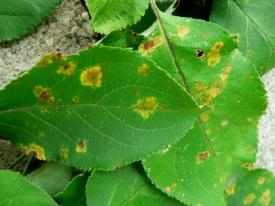

Apple rust - sporangium stage.
|
|
| Severity: | 2 out of 5 |
| Frequency: | 3 out of 5 |
| Symptoms: | On juniper or eastern red cedar, small (3/8 to 1 and 3/16 inches in diameter) galls develop throughout the tree on needles and small twigs. When mature, these galls swell considerably and repeatedly produce orange, gelatinous fruiting structures (telial horns) during rainy spring weather. As spring rains subside, the galls die, which may cause death of the twig from the gall to the tip. On susceptible apples and crabapples, tiny yellow spots appear on the leaves after infection in the spring. As the spots mature, they become yellow/orange and swollen with a red border, and develop tiny black dots (spermagonia) in the center of the lesion on upper leaf surface. By mid-summer, small cup-like structures with tubes (aecia) are visible on the undersides of mature leaf lesions. The fungus may also infect fruit and even succulent twigs of very susceptible apple and crabapple varieties. |
| Cycle: | In order to survive, the fungus must "move" from one type of host to another (e.g., from juniper to apple). See description above. From the telial horns on the juniper, basidiospores are released that infect apples and crabapples. Although these spores may be carried several miles, most infections occur within a several hundred feet from the source juniper. A wet spring period of 4-6 hours at 50-75 F is sufficient for severe infection. Symptoms are described above. Two to four weeks after the tiny dots (spermagonia) appear in the center of each spot, aecia appear on the undersides of leaf lesions. Most people only notice this stage after the aecia have split and take on a ragged appearance. Aeciospores, released from the aecia, become airborne and infect susceptible juniper hosts from midsummer into early fall. The following spring, galls (consisting of both fungal and host plant tissues) begin to develop on the juniper. These galls continue to grow through the summer, and by fall they are full size (3/8 to 1 and 3/16 inches in diameter), greenish-brown to tan and round to kidney shaped. In addition, golf ball-like depressions form on the gall at this time that will give rise to telial horns the following spring. The telial horns are brownish in color, but rapidly elongate and become bright orange with spring rain. Shrinking and swelling of telial horns can occur several times with intermittent rainfall. Each time the telial horns swell, basidiospores are released. After the telial horns have released their spores, the horns collapse, dry and eventually fall off. The galls die at this point, but may remain attached to the juniper for a year or more. In summary, the complete cycle of cedar apple rust takes 24 months to complete and requires infection of two different hosts. |
| Management: | Plant resistant crabapple varieties. Remove all galls from the juniper before the telia form. If you use a fungicide, begin applications at pink flower bud stage and continue, at labeled intervals, 1 to 2 weeks past petal-fall. If the juniper trees are removed within the dimeter of three miles from apple orchard, the risk of rust development on apples will be minimum to none. |
| Associated trees: | |